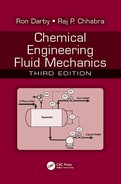Contents
III. Phenomenological Rate or Transport Laws
A. Fourier’s Law of Heat Conduction
C. Ohm’s Law of Electrical Conductivity
1. Momentum Flux and Shear Stress
3. Newtonian and Non-Newtonian Fluids
V. Turbulent Macroscopic (Convective) Transport Models
Chapter 2 Dimensional Analysis and Scale-Up
III. Conservation of Dimensions
VI. Dimensionless Groups in Fluid Mechanics
Chapter 3 Fluid Properties in Perspective
I. Classification of Materials and Fluid Properties
II. Determination of Fluid Viscous (Rheological) Properties
A. Cup and Bob (Couette) Viscometer
B. Tube Flow (Poiseuille) Viscometer
III. Types of Non-Newtonian Fluid Behavior
D. Structural Viscosity Models
IV. Temperature Dependence of Viscosity
II. The Basic Equation of Fluid Statics
B. Horizontally Accelerating Free Surface
V. Static Forces on Solid Boundaries
Chapter 5 Conservation Principles
V. Conservation of Linear Momentum
A. One-Dimensional Flow in a Tube
C. Conservation of Angular Momentum
D. Moving Boundary Systems and Relative Motion
E. Microscopic Momentum Balance
II. General Relations for Pipe Flows
4. Friction Loss in Smooth Pipe
5. Friction Loss in Rough Tubes
6. Friction Loss in Rough Pipe
VII. Tube Flow (Poiseuille) Viscometer
VIII. Turbulent Drag Reduction
Chapter 7 Internal Flow Applications
III. Friction Loss in Valves and Fittings
V. Pipe Flow Problems with Fittings
Chapter 8 Pumps and Compressors
A. Positive Displacement Pumps
III. Pumping Requirements and Pump Selection
E. Frictionless Adiabatic Flow
III. Generalized Gas Flow Expressions: Ideal Gas
C. Solution of High-Speed Ideal Gas Problems
Chapter 11 Safety Relief and Control Valves
3. The Homogeneous Direct Integration Method for Any Single- or Two-Phase Flow
4. Nonequilibrium (Flashing) Flows
B. Overview of Control Valve Sizing
1. The Valve Sizing Coefficient
2. FP: The Piping Geometry Factor
3. The Liquid Pressure Recovery Factor
4. Fd: The Valve Style Modifier
E. Cavitating and Flashing Liquids
2. FF = rc: The Liquid Critical Pressure Ratio
H. General (HDI) Method for All Fluids and All Conditions
J. Matching Valve Trim to the System
Chapter 13 Fluid–Solid Separations by Free Settling
A. Separation of Immiscible Liquids
Chapter 14 Flow in Porous Media
I. Description of Porous Media
B. Porous Medium Friction Factor
C. Porous Medium Reynolds Number
II. Friction Loss in Porous Media
B. Constant Pressure Operation
Chapter 15 Fluidization and Sedimentation
III. Generalized Sedimentation/Fluidization
III. Fluid–Solid Two-Phase Pipe Flows
B. Heterogeneous Liquid-Solid Flows
IV. Gas–Liquid Two-Phase Pipe Flow
B. Homogeneous Gas–Liquid Models
1. Omega Method for Homogeneous Equilibrium Flow
2. Generalized (Homogeneous Direct Integration) Method for All Homogeneous Flow Conditions
Appendix A: Viscosities and Other Properties of Gases and Liquids
Appendix B: Generalized Viscosity Plot
Appendix C: Properties of Gases
Appendix D: Pressure–Enthalpy Diagrams for Various Compounds
Appendix F: Standard Steel Pipe Dimensions and Capacities
Appendix G: Flow of Water/Air through Schedule 40 Pipe
Appendix H: Typical Pump Head Capacity Range Charts
Appendix I: Fanno Line Tables for Adiabatic Flow of Air in a Constant Area Duct
